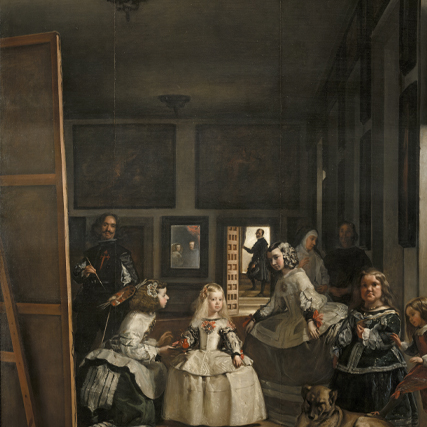The Enigmatic Beauty of Velázquez’s “Las Meninas”

Diego Rodríguez de Silva y Velázquez, one of the most celebrated painters of the Spanish Golden Age, left behind a timeless masterpiece that continues to captivate art enthusiasts and scholars alike: “Las Meninas” (The Maids of Honor). Painted in 1656, this iconic artwork has perplexed viewers for centuries, evoking discussions about its composition, symbolism, and enigmatic nature. In this article, we shall delve into the multifaceted layers of Velázquez’s “Las Meninas,” exploring its historical context, artistic significance, and enduring legacy.
I. The Historical Context
To truly appreciate the significance of “Las Meninas,” one must comprehend the historical context surrounding its creation. During the 17th century, Spain was under the Habsburg rule, and King Philip IV, a patron of the arts, reigned over the Spanish Empire. Velázquez served as the official court painter, and it was within this privileged position that he had the opportunity to immortalize the royal family through his art. “Las Meninas” depicts a scene inside the Alcázar of Madrid, the royal residence, presenting an intimate glimpse into the life of the Spanish court.
II. Unraveling the Composition
At first glance, “Las Meninas” appears to be a simple portrayal of Infanta Margaret Theresa, the king and queen’s daughter, surrounded by her maids of honor and courtiers. However, Velázquez’s masterful composition and use of visual elements reveal a deeper complexity.
A. The Play of Light and Shadow
Velázquez’s keen understanding of light and shadow is evident in “Las Meninas.” He skillfully manipulates light to create depth and volume, imbuing the characters with a sense of presence. The spotlight on the Infanta draws the viewer’s attention to her, while the surrounding figures are strategically placed in varying degrees of shadow, contributing to the painting’s visual drama.
B. The Mirror and the Enigmatic Reflection
One of the most intriguing aspects of “Las Meninas” is the mirror in the background, reflecting the image of King Philip IV and Queen Mariana. The mirror’s presence raises questions about the perspective and reality within the artwork. Some art historians suggest that the mirror serves as a representation of the viewer, inviting them into the scene as an unseen participant in the royal world.
C. The Subtle Presence of Velázquez
Though not immediately noticeable, Velázquez himself is present in the painting. He appears to be working on the canvas on which “Las Meninas” is painted, thus positioning himself as both the creator and an integral part of the court’s inner circle. This self-reference sparks discussions about the role of the artist in the court and the relationship between art and reality.
III. Symbolism and Interpretations
“Las Meninas” is rich in symbolism, which has prompted numerous interpretations over the centuries. Different art critics and scholars have offered varying explanations for the underlying messages within the artwork.
A. The Infanta’s Gaze
Infanta Margaret Theresa’s direct gaze towards the viewer has fascinated many. Some interpret her gaze as a challenge to the viewer’s authority, as if she is aware of her royal status and confident in her power. Others suggest that her gaze is a plea for attention or acknowledgment from her parents, the king and queen, emphasizing the isolation she might have felt in the grandeur of the court.
B. The Role of the Maids of Honor
The maids of honor in the painting play a significant role beyond being mere attendants. They are portrayed with individual personalities, and some critics argue that they represent different aspects of femininity, virtue, or even stages of life. These interpretations shed light on the diverse roles women played within the court and society at large during the 17th century.
C. The Habsburg Dynasty
The presence of the mirror reflecting the king and queen has led to interpretations concerning the Habsburg dynasty’s precarious future. The Habsburgs were known for their intermarriages, which often led to genetic disorders. The mirror’s inclusion might be seen as a commentary on the importance of securing a strong lineage through royal marriages.
IV. Influence and Legacy
Despite its initial reception as an unconventional work, “Las Meninas” has become an art-historical touchstone, influencing countless artists and shaping the development of different art movements over the centuries.
A. Influence on Modern Art
The concept of breaking the traditional barriers between the viewer and the subjects in “Las Meninas” foreshadowed elements of modern art movements like Impressionism and Cubism. Artists such as Pablo Picasso were notably inspired by Velázquez’s composition and used it as a basis for their own groundbreaking works.
B. “Las Meninas” in Popular Culture
Beyond the realm of fine arts, “Las Meninas” has permeated popular culture in diverse ways. It has been referenced and recreated in literature, music, and cinema, attesting to its enduring appeal and cultural significance.
Velázquez’s “Las Meninas” remains an enigmatic and captivating masterpiece, one that transcends time and continues to inspire generations of artists and thinkers. Through its intricate composition, skillful use of symbolism, and powerful evocation of the Spanish court, the painting invites viewers to ponder the complexities of art, reality, and human relationships. As long as the art world exists, “Las Meninas” will undoubtedly hold its place as one of the most iconic and thought-provoking works in the history of art.
Where to sleep next to the Las Meninas?
If you want to sleep a few steps away from Las Maninas, SmartRental offers you our network of luxury aparthotels in the heart of Madrid’s Gran Vía: SmartRental Gran Vía Centric and SmartRental Gran Vía Capital or Akeah Hotel.
Do you need more information? Contact us at:
Or book online here
